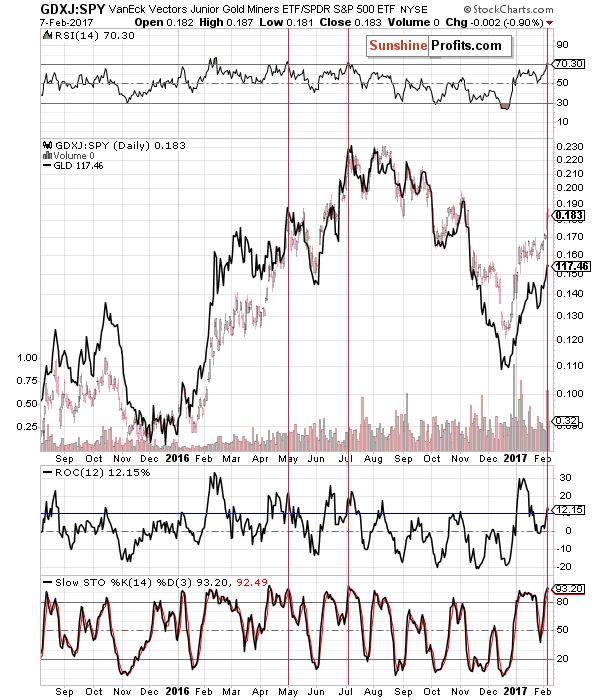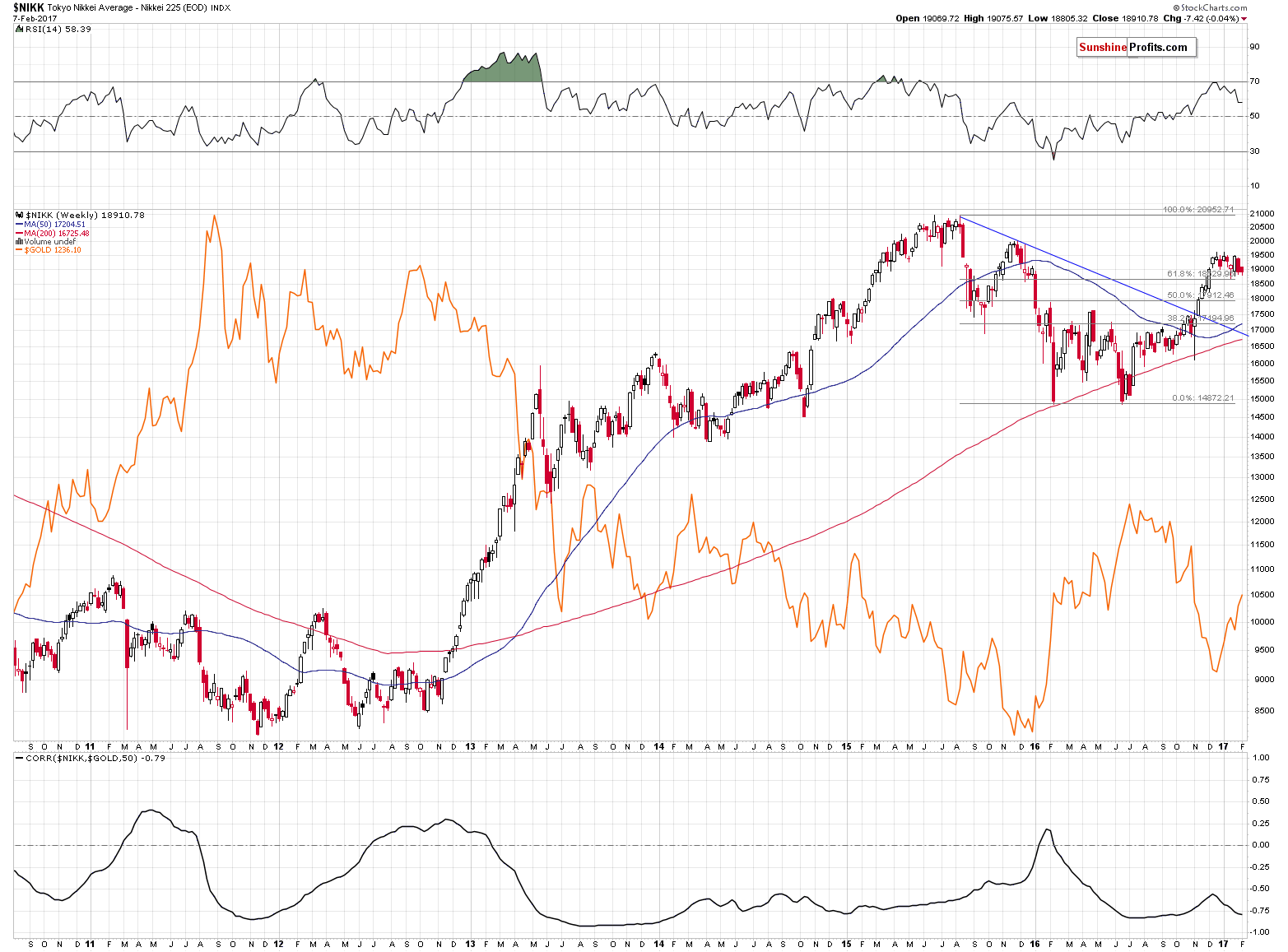Briefly: In our opinion, full (150% of the regular full position) speculative short positions in gold, silver and mining stocks are justified from the risk/reward perspective. This position was originally featured on Jan. 12, 2017 at 3:49PM.
Not much happened in the precious metals market yesterday, so instead of repeating what we wrote then (the analysis remains up-to-date – the USD Index is after a breakout above the declining resistance line), we will discuss 2 little-known developments that are happening right now. The first one is the performance of the precious metals junior mining stocks and the second one is the performance of Japanese stocks – the Nikkei Index. Let’s start with the former (charts courtesy of http://stockcharts.com).

The above chart features the performance of junior mining stocks relative to the general stock market. The ratio is drawn using candlesticks and is less visible, while the price of gold (GLD) is drawn using a black line and is more visible. It’s clear that the GDXJ:SPY ratio and GLD are moving in tune with each other. Consequently, a top in the ratio is likely to correspond to a top in gold. The reason we are featuring the above chart is that we saw a sell signal from the RSI indicator based on the ratio. The RSI moved above 70 and the last 2 times that we saw something like that, the ratio and gold formed important tops, including the 2016 top.

The second thing that we would like to discuss is the situation in the Nikkei Index. The reason that we are mentioning it, is the strong inverse correlation it has with gold. It’s not necessarily visible on a day-to-day basis, but the key moves correspond to each other. Now, what’s happening in Japanese stocks? They broke above the 61.8% Fibonacci retracement level and have been consolidating since that time. The breakout was verified and it was not invalidated, which technically means that the rally that we saw in the second half of 2016 was not a corrective upswing, but a beginning of another move up. The consolidation has been in place for about 2 months, which is more than enough to cool down the traders’ emotions – the rally in the Nikkei can definitely continue any day now and the opposite is the case with gold.
Summing up, the bearish signals that we discussed yesterday remain in place, but there are also other reasons to think that lower precious metals prices are just around the corner, including junior mining stocks and their recent outperformance and the bullish outlook for Japanese stocks.
As always, we will keep you – our subscribers – informed.
To summarize:
Trading capital (supplementary part of the portfolio; our opinion): Short positions (150% of the full position) in gold, silver and mining stocks are justified from the risk/reward perspective with the following stop-loss orders and initial target price levels / profit-take orders:
- Gold: exit-profit-take level: $1,063; stop-loss: $1,263; initial target price for the DGLD ETN: $81.88; stop-loss for the DGLD ETN $48.47
- Silver: initial target price: $13.12; stop-loss: $18.07; initial target price for the DSLV ETN: $46.18; stop-loss for the DSLV ETN $22.24
- Mining stocks (price levels for the GDX ETF): initial target price: $9.34; stop-loss: $26.34; initial target price for the DUST ETF: $143.56; stop-loss for the DUST ETF $21.37
In case one wants to bet on junior mining stocks' prices (we do not suggest doing so – we think senior mining stocks are more predictable in the case of short-term trades – if one wants to do it anyway, we provide the details), here are the stop-loss details and initial target prices:
- GDXJ ETF: initial target price: $14.13; stop-loss: $45.31
- JDST ETF: initial target price: $104.26; stop-loss: $10.78
Long-term capital (core part of the portfolio; our opinion): No positions (in other words: cash)
Insurance capital (core part of the portfolio; our opinion): Full position
Please note that the in the trading section we describe the situation for the day that the alert is posted. In other words, it we are writing about a speculative position, it means that it is up-to-date on the day it was posted. We are also featuring the initial target prices, so that you can decide whether keeping a position on a given day is something that is in tune with your approach (some moves are too small for medium-term traders and some might appear too big for day-traders).
Plus, you might want to read why our stop-loss orders are usually relatively far from the current price.
Please note that a full position doesn’t mean using all of the capital for a given trade. You will find details on our thoughts on gold portfolio structuring in the Key Insights section on our website.
As a reminder – “initial target price” means exactly that – an “initial” one, it’s not a price level at which we suggest closing positions. If this becomes the case (like it did in the previous trade) we will refer to these levels as levels of exit orders (exactly as we’ve done previously). Stop-loss levels, however, are naturally not “initial”, but something that, in our opinion, might be entered as an order.
Since it is impossible to synchronize target prices and stop-loss levels for all the ETFs and ETNs with the main markets that we provide these levels for (gold, silver and mining stocks – the GDX ETF), the stop-loss levels and target prices for other ETNs and ETF (among other: UGLD, DGLD, USLV, DSLV, NUGT, DUST, JNUG, JDST) are provided as supplementary, and not as “final”. This means that if a stop-loss or a target level is reached for any of the “additional instruments” (DGLD for instance), but not for the “main instrument” (gold in this case), we will view positions in both gold and DGLD as still open and the stop-loss for DGLD would have to be moved lower. On the other hand, if gold moves to a stop-loss level but DGLD doesn’t, then we will view both positions (in gold and DGLD) as closed. In other words, since it’s not possible to be 100% certain that each related instrument moves to a given level when the underlying instrument does, we can’t provide levels that would be binding. The levels that we do provide are our best estimate of the levels that will correspond to the levels in the underlying assets, but it will be the underlying assets that one will need to focus on regarding the signs pointing to closing a given position or keeping it open. We might adjust the levels in the “additional instruments” without adjusting the levels in the “main instruments”, which will simply mean that we have improved our estimation of these levels, not that we changed our outlook on the markets. We are already working on a tool that would update these levels on a daily basis for the most popular ETFs, ETNs and individual mining stocks.
Our preferred ways to invest in and to trade gold along with the reasoning can be found in the how to buy gold section. Additionally, our preferred ETFs and ETNs can be found in our Gold & Silver ETF Ranking.
As always, we'll keep you - our subscribers - updated should our views on the market change. We will continue to send out Gold & Silver Trading Alerts on each trading day and we will send additional Alerts whenever appropriate.
The trading position presented above is the netted version of positions based on subjective signals (opinion) from your Editor, and the Tools and Indicators.
As a reminder, Gold & Silver Trading Alerts are posted before or on each trading day (we usually post them before the opening bell, but we don't promise doing that each day). If there's anything urgent, we will send you an additional small alert before posting the main one.
=====
Latest Free Trading Alerts:
Last week, the London Bullion Market Association published a new edition of its quarterly journal called “Alchemist.” What can we learn from this publication?
On Monday, crude oil lost 1.52% after oil investors reacted to Friday’s Baker Hughes’ report, which showed that U.S. drillers added 17 rigs, which was the 13th increase in the past 14 weeks. Thanks to this news light crude reversed and declined to the previously-broken short-term support/resistance line. Will it manage to stop oil bears in the coming days? Is it possible that the relationship between gold and crude oil give us more clues about oil’s future moves?
Oil Trading Alert: Gold and Oil Link – What Does It Say?
=====
Hand-picked precious-metals-related links:
Gold Miners Burned by Bad Deals Are Again Rushing to M&A
China's 2016 Gold bar and coin demand marks strongest since 2013
Gold Bullion Banks To “Open Vaults” In Transparency Push?
Lukewarm start for new London Gold Futures Contracts
=====
In other news:
Demand for Treasuries Is Now a ‘Made in the U.S.A.’ Phenomenon
Bonds Plunge as India Unexpectedly Signals End to Easing Cycle
Russia Shows Why China Should Just Stop Burning Up Its Reserves
Greece in focus as investors fear fresh crisis - business live
The IMF Staff Has It Right on Greece
Cracks Are Appearing in Australia’s Trillion-Dollar Debt Pile
How Goldman Sees a Trump Trade War Hurting U.S.-China GDP Growth
China Central Bank Said to Call Bitcoin Exchanges for Talks
=====
Thank you.
Sincerely,
Przemyslaw Radomski, CFA
Founder, Editor-in-chief, Gold & Silver Fund Manager
Gold & Silver Trading Alerts
Forex Trading Alerts
Oil Investment Updates
Oil Trading Alerts



